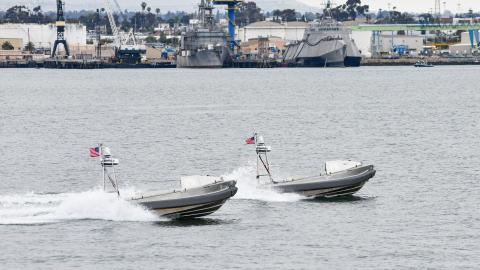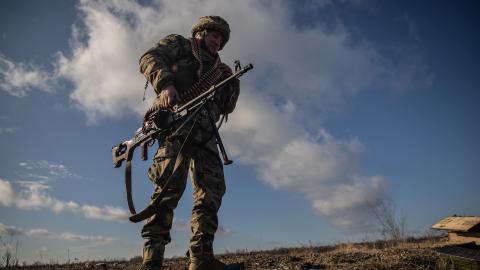Below Senior Fellow Can Kasapoğlu offers a military situation report about the war in Ukraine.
Executive Summary
• Moscow-Pyongyang cooperation: Ukraine captured several North Korean troops in the Russian region of Kursk and posted videos of their interrogations online.
• Battlefield assessment: The Russian military maneuvered to cut Ukraine’s access to critical highways on the Pokrovsk front as Kyiv’s forces continue to endure worrisome force generation problems.
• Drone warfare update: Ukrainian long-range drones hit targets deep inside Russia, while Russian fiber-optic-enabled drones troubled Ukrainian defenses.
1. North Korean Casualties Mount in Kursk
North Korea has continued to deepen its engagement in the Russian region of Kursk, where Pyongyang’s troops have been pushed into high-risk offensive tasks. South Korean intelligence estimates that hundreds of North Korean fighters have been killed in action, and thousands more wounded. But despite these casualties, North Korea has continued to rotate and reinforce its troops, showcasing its commitment to Russia’s war.
Notably, Ukraine has captured some of these troops, and Ukrainian President Volodymyr Zelenskyy has posted videos of their interrogations on his X account. South Korean news outlets reported that the captured troops were serving with the North Korean Reconnaissance General Bureau, a key intelligence agency. While Ukraine has yet to capture a high-ranking North Korean officer, this possibility cannot be ruled out.
Nonetheless, Pyongyang will likely send additional troops from its most elite formations to Kursk—and possibly to occupied Ukraine. American officials report that Russia has agreed to supply North Korea with Su-27 and MiG-29 combat aircraft in return for its contributions. The two allies may also share ballistic missile technology and submarine systems. These developments demonstrate that Kyiv and Seoul need to deepen their security and intelligence cooperation.
2. Battlefield Assessment
Today 18 percent of Ukraine is under Russian occupation. Despite high casualties, the Russian military maintains an offensive footing on multiple fronts.
The Kremlin’s abundance of manpower highlights Ukraine’s force generation troubles. Kyiv has denied social media claims that it transferred technicians from the Ukrainian Air Force to help stabilize the front lines. But press sources indicate that President Zelenskyy intervened to countermand this decision.
True or not, these rumors point to a grim reality. Over the past week, the Russian military has successfully pushed onto the highway network surrounding Pokrovsk. It has likely secured Neskuchne, to the southwest of Velyka Novosilka, where Russian combat formations have already been operating along the Mokri Yaly River. Russia has also gained territory in Toretsk and Kurakhove.
In Kursk, Russia and Ukraine have been conducting separate tactical offensives at high operational tempos. As in previous weeks, Russia’s operational concepts have involved launching both mechanized, echeloned attacks and waves of soldiers at Ukrainian defenses. Ukraine’s attempts to hit the Russian rear with fire-support weapons have found some success: on January 7, Kyiv conducted a precision strike against Russia’s 810th Separate Marine Brigade in Kursk.
3. Drone Warfare Update
As previous editions of this report have highlighted, Russia has continued to use first-person-view (FPV) drones equipped with fiber-optic cables to counter Ukraine’s electronic warfare efforts in Kursk. In recent interviews, Ukrainian personnel have stated that they have resorted to using shotguns against these drones because other defenses have failed.
Russia continued to launch loitering munition salvos against Ukraine, employing predominantly Iranian Shahed drones. The Kremlin’s target set included Ukraine’s population centers and energy grid. Statistical assessments suggest that Moscow, with Tehran’s help, has the capacity to launch over 1,500 Shaheds per month.
In drone warfare, volume matters. Roughly half of Russia’s strike packages fail to breach Ukraine’s air defenses and others fall prey to Kyiv’s electronic warfare efforts. But even a low rate of success can cause significant damage. In November 2024, its most prolific month to date, the Russian military launched 2,300 kamikaze drones at Ukraine. Iranian drones will likely continue to grow in importance throughout 2025.
Two bright spots did emerge for Ukraine. First, Defense Intelligence of Ukraine (GUR) operatives managed to infiltrate the Russian rear area and inflict damage on enemy units. Second, Ukraine used its robust long-range strike capabilities to conduct overwhelming strikes deep inside Russia, most prominently in a January 14 attack on ammunition depots at the Engels-2 air base and various chemical plants.



















